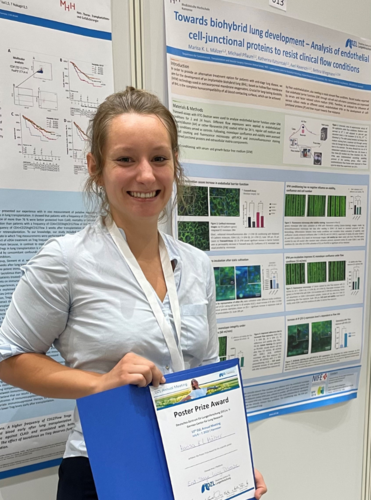Currently, lung transplantation (DLTx) is the only lifesaving therapy option for patients with endstage pulmonary diseases. Due to the annual increase in the number of those affected and the increasingly limited availability of donor organs, this is, though, only an option for a small number of people. However, in order to be able to offer all patients with terminal lung diseases an alternative to DLTx, the Wiegmann working group at BREATH is working on the development of the biohybrid lung (BHL), which is based on the technical concept of extracorporeal membrane oxygenation (ECMO).
When the gas exchange performance of the patient’s own lung is no longer sufficient, those affected can be kept alive with the ECMO, which temporarily takes over the lung function. The patient’s blood is directed from the body through a cannula and oxygenated via polymethylpentene (PMP) hollow fiber membranes (HFM), and carbon dioxide is removed, before it is then fed back into the body. Through the inevitable contact of the circulating blood with the foreign surfaces of the ECMO, however, the coagulation system is activated, which can lead to the formation of blood clots. This must be suppressed immediately by giving the patient high-dose anti-coagulants. Despite adequate medication, however, this clot formation cannot be permanently avoided, so that, amongst other things, due to the ECMO, the blood flow may come to a standstill already after only a few days or weeks.
Based on these serious, partially life-threatening side effects, the application period of ECMO is timewise strictly limited and can therefore not be considered as an alternative to DLTx, particularly since the ECMO patients must be monitored in intensive care. Only when coagulation has been effectively avoided and the absence of clot formation is guaranteed can the long-term use and implantation of such a system be justifiable.
In order to do this, the working group of PD Dr. Wiegmann is committed to this, whereby they developed the so-called biohybrid lung on the technological basis of the ECMO system. Here, the primary goal is to cover all blood-contacting surfaces with a bioidentical layer of blood vessel endothelial cells (EC), so that blood clots can no longer form on the foreign surfaces, thus rendering it unnecessary to administer blood thinners. Successful accomplishment of this idea could also already be demonstrated for the HFM under static conditions. Under flow dynamic conditions, it has however been noticed that cells occasionally detach themselves from the cell bond. Zellverbrand In Ms Mälzer‘s promotion project, possibilities were therefore sought to enhance the flow resistance of the cells, in order to avoid this dissolution. Based on findings from research on the blood-brain barrier, which show that pre-treatment of the endothelial cell layer with serum- and growth factor-free culture medium (SFM) leads to strengthening of the cell-cell connections and the cellular barrier function (BF), it is hypothesized that this reinforcement also has a positive effect on the fluid-dynamic cell preservation of the biohybrid lung (BHL).
Next, in the so-called transwell assay, the described strengthening effect could be confirmed with the relevant ECs for BHL development. Here, the increase in BF was correlated with a denser form of interstitial connections (ZZV). Subsequently, this was also found to be the case for the endothelial cell group on albumin/heparin- and fibronectin-coated HFM, for which the SFM incubation also led to a seamless cell lawn with a microscopically visible increase in ZZV. Particularly after a 2-hour SFM-pretreatment, this effect could also be confirmed on a genetic level due to the increased expression of ZZV-associated proteins. Subsequently, both SFM-incubated and endothelial cell lawns without SFM pretreatment were exposed for 24 hours on the varyingly coated HFM clinically relevant flow conditions and then compared. This showed a significantly improved conservation of the unbroken cell bond with previous SFM pretreatment, whereby this effect was most evident on the fibronectin-coated HFM.
The results gained in this work will be included in the future optimal flow adaptation protocol of the endothelial cell bond on the HFM, to optimally prepare the cells for the clinically relevant flow conditions within the BHL. These data are thus a further important step in the direction of translational realization of the BHL and the „first-in-human“ use as an alternative to DLTx.
Text: BREATH/ WG Wiegmann
Photo: private

Poster Prize winner Marisa Mälzer